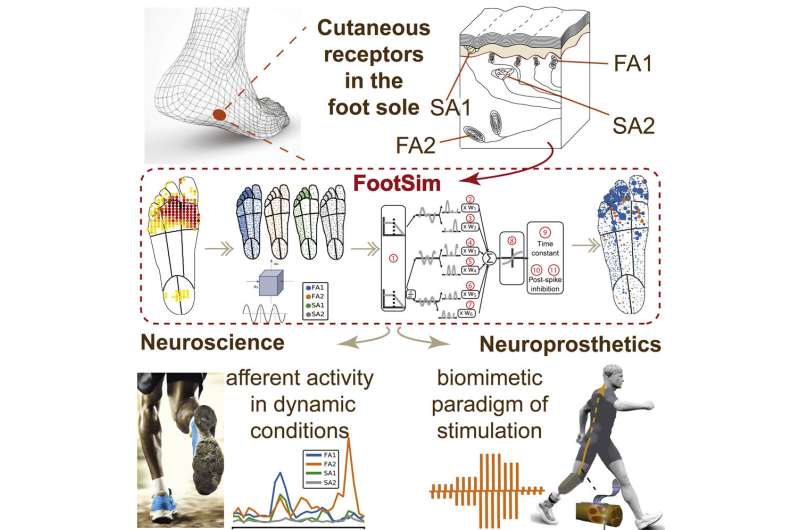
A digital foot sole that enables scientists to see the neurological signals that control how we walk and maintain balance, has been developed by researchers at the University of Sheffield.
The groundbreaking computational model, which provides a digital simulation of the signals that continuously flow through the body from the foot to the brain, could be used to design more sophisticated neuroprosthetics—artificial limbs that can give the brain feedback about the world around us, in electrical form.
Called FootSim, the model allows scientists to map how our nervous system continuously responds to contact with the soles of our feet and changes in pressure points in unprecedented detail.
The digital sole model has been developed by Dr. Rodrigo Kazu Siqueira, a Computational Neuroscientist at the University of Sheffield, and Natalija Katic, a Ph.D. student at ETH Zurich and the University of Belgrade.
Dr. Kazu Siqueira, from the University of Sheffield, said, “To walk and maintain balance, humans rely on continuous feedback from the soles of our feet. This information is sent in the form of electronic signals that travel through neurological pathways between our feet and brain.
“Until now, it has been incredibly difficult for scientists to study these signals, which makes it difficult to fix them when they’re disrupted or replicate them, for example in the use of bionic limbs.
“The model we’ve developed here at Sheffield now enables us to replicate the signals that allow the nervous system to walk and maintain balance in unprecedented detail. This level of insight opens up a world of possibilities, particularly for the future of healthcare. It could be used to help design new, more sophisticated assistive technologies that are more stable, responsive and reliable.”
Dr. Kazu Siqueira is part of Dr. Hannes Saal’s Active Touch Laboratory, and together with Luke Cleland, a Ph.D. student from the group, programmed the model in Sheffield’s Insigneo Institute for in silico Medicine—Europe’s first research institute dedicated to using new digital technologies to transform the future of healthcare. The work was done in collaboration with Canadian researchers from Guelph and Calgary universities and with a group led by Dr. Stanisa Raspopovic at ETH Zürich that has a history of successful and impactful research in prosthetics.
The FootSim model is described in a new paper published in the journal iScience.
More information:
Natalija Katic et al, Modeling foot sole cutaneous afferents: FootSim, iScience (2022). DOI: 10.1016/j.isci.2022.105874
Journal information:
iScience
Source: Read Full Article
